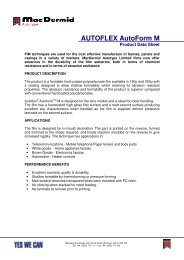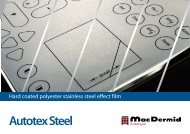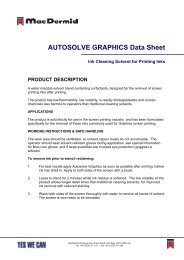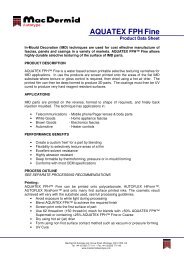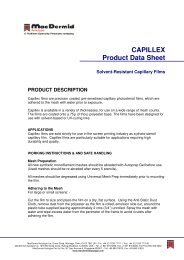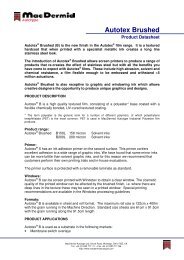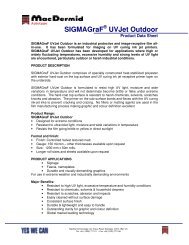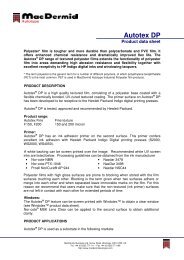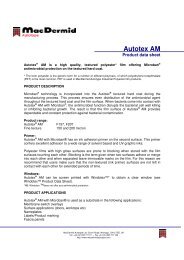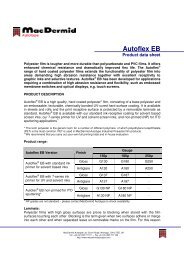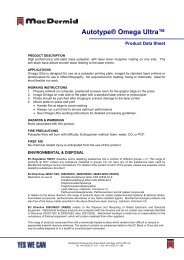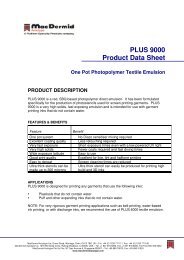Screen E-Book (.PDF) - MacDermid Autotype
Screen E-Book (.PDF) - MacDermid Autotype
Screen E-Book (.PDF) - MacDermid Autotype
- No tags were found...
You also want an ePaper? Increase the reach of your titles
YUMPU automatically turns print PDFs into web optimized ePapers that Google loves.
Arguably the skipping takes place preferentiallyin holes surrounded by mountainsof other dots, and these holes form somesort of pattern. But the frequency of theseskipping dots are too high to be a real moiré.Instead, the eye just picks them out asbeing plain old ugly.Spreading, gives another ‘moiré’ effect thathas sometimes puzzled us. This particulareffect drifted in and out during the printrun and defied all rational moiré analyses.It also gave a peculiar wavy pattern thatlooked as if it might be a mesh moiré, butwe had the data to rule out this particularcause. Then we realised that the effect wasdue to extra dots of ink appearing wherethey shouldn’t. How can dots appear fromnowhere? They are remnants of spreadingdots underneath the stencil. If each subsequentprint is exactly in register with theprevious print, then this extra amount of inkwill print as classic spreading dot gain. Butslight mis-registration means that thesedots can appear between other dots andgive rise to moiré-like effects. The wavinesscame from the fact that the spreading dotswere rather widely spaced on the bottomof the previous print (because they arelong-range interactions with the underlyingrosette) and only show up as a ‘moiré’when, by chance, they span a pair of newlyprinted dots – and the positions of theseinteractions are not regular. It was a goodexample of how important it is to combineboth pure science and hands-on analysis.The pure computer model couldn’t possiblyanticipate such an effect as it assumesperfect registration every time!If you have very low frequency variationsin your process, e.g. if you use banks of UVfluorescent tubes for exposure instead of aUV lamp, you will be able to see variationsin your print. But because the frequency ofthe effect is exactly that of your variation,it’s not really a moiré. Theoretically you canget additional moiré effects, but in practiceyou would have to be very unlucky. Moirétends to be most severe when angles andfrequencies are very similar.Printers often complain of a type of moiréin their vignettes – those gentle fadingtints that designers love and printers hate.This ‘moiré’ appears as regular bands. Butthis isn’t moiré. It’s tonal banding resultingfrom the limitations of PostScript screens.If you try to print at 120 lpi with a 1200dpiimagesetter you will only get 100 differentlevels of grey. So instead of a gentle gradationyou will see 100 individual steps. Thefix for this is a lower lpi, a higher dpi imagesetteror a more sophisticated RIP thatcan extend the tonal range.You can also get different types of tonaljumps depending on your dot shapes.Round dots give one big tonal jump, ellipticaldots give two smaller jumps.One way to reduce moiré is to introducenoise to confuse the eye. I once tried todo this and found that it needed a surprising,and unacceptable amount of noise todo a good job. However, there is some evi-120



